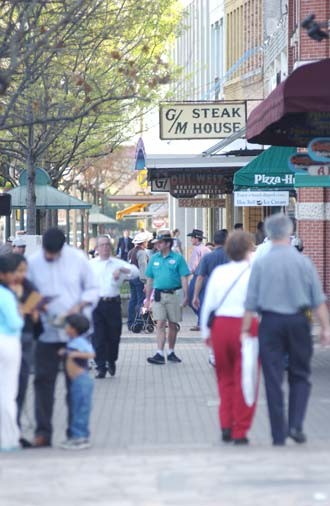Tourism, while no longer San Antonio's top industry, is still the city's most visible one. Yet there is an invisible - and contentious - aspect of tourism that affects not only visitors who buy trinkets near the Alamo, but residents as well: the dreaded, unsexy, pain-in-the-ass hotel-motel occupancy tax.
San Antonio levies a 16.75 percent HOT tax, as it's known, on every hotel or motel room. To translate this into
| Tourists and locals mill about in front of businesses on Alamo Plaza. About 100 yards north on Houston Street are blocks of empty or near-vacant buildings and storefronts. Photo by Mark Greenberg |
The City's exorbitant HOT tax ranks second in the nation; Houston, which lays a 17 percent surcharge on every hotel room, has the dubious honor of ranking first.
So what, you say? Stick it to the tourists.
But the HOT tax is also sticking it to you.
"After the hotels charge their tax and people rent a car, then what do they have left?" says Ann Earl, co-owner of Echoes From the Past, a locally owned antique and nostalgia shop on East Houston Street. "If they don't have extra money, they can't buy anything. It's killing us."
The mom-and-pops aren't the only businesses hurting from the high tax. "The HOT tax really concerns me," explains Henry Feldman, president of La Mansión Hotel. "The margins in the hotel industry are so thin, and we have to discount room rates because of the tax."
Discounting room rates means smaller profits. And if a hotel isn't making enough money, it will be less likely to give its banquet servers, maids, and desk clerks a raise. The tax also shoos people out of town more quickly, meaning they spend less at restaurants and shops; the decrease eventually trickles down to local wages and workers. "I don't know how many people have stood in front of this counter and told me, 'If it weren't for the tax, I'd spend one more night,'" explains Earl.
And if they don't spend money at the usual tourist haunts, then local residents like Earl also have less money to flow to the local, non-tourism-based economy.
Several hands dip into the HOT tax cookie jar: The state takes its share to entice more people to Texas, and the City receives about $40 million for the general fund. About 40 local arts organizations receive money through the tax. The Convention Center skims its part to decrease its debt. But to many locals' chagrin, the tax also pays off controversial bonds that built two Spurs shrines: the SBC Center - which city leaders located off the beaten path (and if you've driven Houston Street, you know that beaten aptly describes it) - and the main albatross, the Alamodome, which is operating in the red and only occasionally hosts events.
Although the pending Toyota plant and continued growth in biomedical industry will help diversify San Antonio's economy, there are no other obvious replacements for HOT tax funds, notes Ramiro Cavazos, the city's economic development director. "Otherwise we would have to shift to property taxes, sales tax and CPS revenue" he says, to pay many of the city's bills.
Therein lies the rub: As the city tries to curb its addiction to tourism, it must decrease its dependence on the HOT tax. But with the arts to support, arenas to build, and 80,000 jobs to maintain, the city cannot easily kick the habit. •


